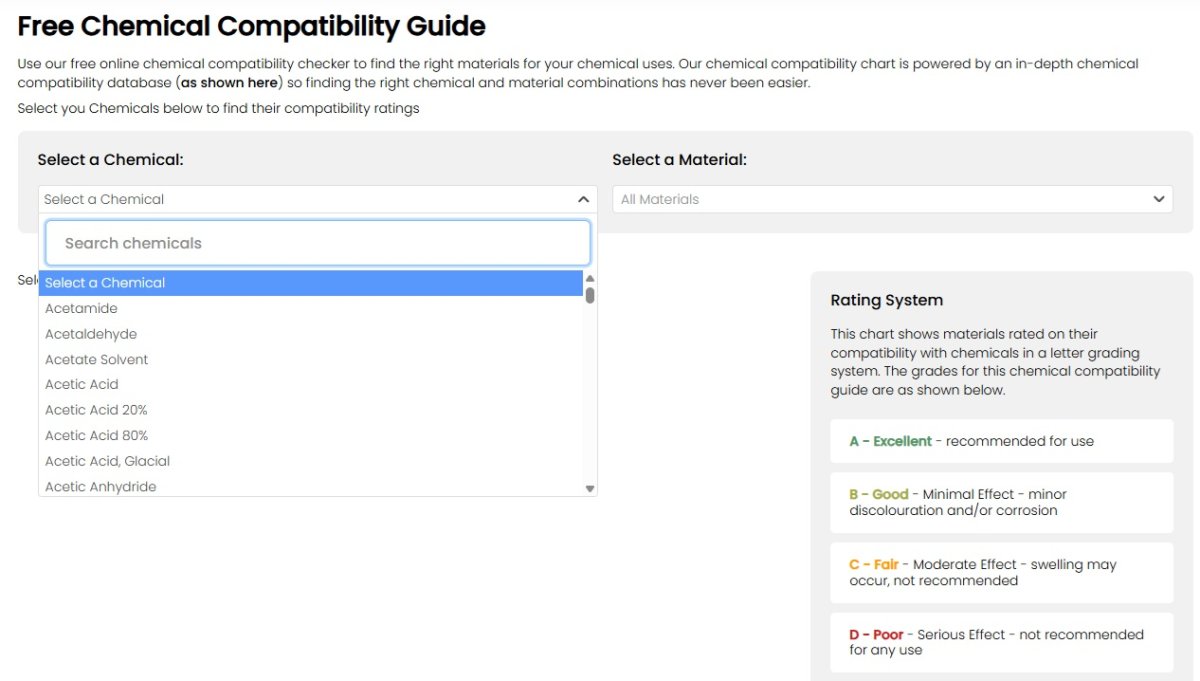Chemical Compatibility Guide for Solenoid Valves
Select the correct Valve Material for your application

Free Interactive Chemical Compatibility Guide

Find the Right Valve Material for Your Chemical Application
Choosing the wrong material for a solenoid valve in a chemical system can lead to corrosion, leakage, or even hazardous failure. That’s why Solenoid-Valve.World provides a detailed chemical compatibility guide to help you select the right valve body and seal materials for the substances you’re working with.
Whether you’re dealing with acids, solvents, water, oils, or industrial gases, we offer expert insights into which materials resist which chemicals—ensuring safe and long-lasting performance.
Why Chemical Compatibility Matters
A solenoid valve must maintain a tight seal and structural integrity even under aggressive chemical exposure. Material degradation can cause:
Valve failure or leakage
Dangerous chemical reactions
Increased maintenance costs
Reduced system efficiency
Selecting the correct valve material from the start prevents these issues and extends the lifespan of your system.
How to Use This Chemical Guide
1. Identify the chemical flowing through your valve (e.g., sulphuric acid, acetone, ammonia).
2. Check our compatibility tables to find suitable body and seal materials (e.g., PTFE, EPDM, FKM, Stainless Steel).
3. Match your choice with one of our solenoid valve models that offer those materials.
Need a shortcut? Contact us with your media type and we’ll recommend the best option.
Common Materials and Their Resistance Profiles
Valve Body Materials:
Brass – Excellent for water, air, and non-aggressive fluids
Stainless Steel (316) – Highly resistant to acids, salts, and corrosive chemicals
PVC/PP/PTFE – Ideal for aggressive acids, alkalis, and solvents
Aluminium – Lightweight and cost-effective; limited chemical resistance
Seal Materials:
EPDM – Great for water, steam, and many alkalis
FKM (Viton®) – Excellent for oils, fuels, and many acids
NBR (Buna-N) – Suitable for oils and hydrocarbons
PTFE (Teflon®) – Universal resistance; great for harsh chemicals
Explore the Full Chemical Compatibility Guide
We’ve created a downloadable chemical resistance chart that lists hundreds of chemicals and their compatibility with common valve materials. Use it as a reference when designing or upgrading any fluid control system.
Looking for a specific chemical? Contact us for expert advice.
Application Examples
Laboratory dosing systems
Water treatment plants
Pharmaceutical production
Chemical storage tanks and transfer lines
Cleaning-in-place (CIP) systems
Need Help Choosing? We’re Here to Assist
Our technical team can match your application with the best valve materials for your chemical. Whether you need a PTFE-lined solenoid valve, acid-resistant stainless steel valve, or custom solution, we’ll guide you to the right product.
Email: sales@solenoid-valves.com
Call: 01454 334 990
Choose Chemical-Compatible Solenoid Valves with Confidence
Avoid the risk of material failure. Use our chemical compatibility guide to ensure that your solenoid valve lasts longer, performs better, and keeps your system safe.
Other Chemical Compatibility Charts
Connexion Chemical compatibility chart for
PP, 316SS, Carbon, Ceramic, PTFE, EPDM, FKM and NBR
Connexion 760 Chemical compatibility chart for
Stainless steel 302; 304; 316 and 440, Aluminium, Titanium, Hastelloy C, cast bronze, cast iron, Carbon steel, PVC, Tygon E3606, Teflon (PTFE), Noryl, Cycolac (ABS), Polyethylene, Polypropylene, Ryton, Carbon, Ceramic, Ceramagnet A, Viton, Buna N (Nitrile), Silicon, Neoprene, Ethylene Propylene (EPM), Rubber (natural) and epoxy.
Connexion 560 chemicals compatibility chart for
Aluminium, Brass, Carbon Steel, Ductile Iron, 316 Stainless steel, Alloy 20, Monel, Hastelloy C, Buna N NBR, Delrin, EPDM, Viton, Hypalon, Neoprene, Nylon and Teflon PTFE across 1000+ known chemicals.
Connexion chemical compatibility chart 1
ABS, CPVC, PP, PVC, PVDF, PEX, PPSU, PTFE, EPDM, Nitrile (buna n), Polychloroprene, FKM, Graphite, Bronze, Silicon Bronze, Aluminium bronze, Brass, Gray iron, Ductile iron, carbon steel, 3% Nickel / iron, nickel plated ductile iron, stainless steel 400, 316 stainless steel and copper.
Connexion Gas Compatibility chart 2
Brass, 303 Stainless steel, 316 stainless steel, Aluminium, Zinc, Copper and Monel, Plastics (PCTFE, Teflon, Tefzel, Kynar, PVC and Polycarbonate), and Elastomers (Kalrez, Viton, Buna-N, Neoprene and Polyurethane).
Chemical compatibility chart 3
FFKM, ETP, FKM, NBR, HNBR, EPDM, TFE/P, VQM, FVQM, AU and PTFE. Includes more of the gases typically used for refrigeration systems.
Chemical compatibility chart 4
Aluminium, Carbon Steel, Ductile Iron, 304 stainless steel, 316 stainless steel, Acetyl, Buna, CSM (Hypalon), EPDM, Fluorocarbon, Fluoroelastomer (FKM), Geolast (Buna & Polypropylene), Hastelloy C, TPE, Leather, Nitrile (TS), Nitrile (TPE), Nylon, Polychloroprene, Polypropylene, PTFE, PVDF, Santoprene (EPDM & Polypropylene), UHMWPE and Urethane against 1600+ different media types.
Chemical compatibility chart 5:
Copper and Copper alloys including Aluminium Bronze, Brass, Copper, Copper-Nickel 90/10 alloys and Gunmetal and Bronze
These lists are not a guarantee that the material or valve are compatible with the media, they are given as a guide and all special applications should be checked against the materials of construction or with your chemical supplier laboratory.
